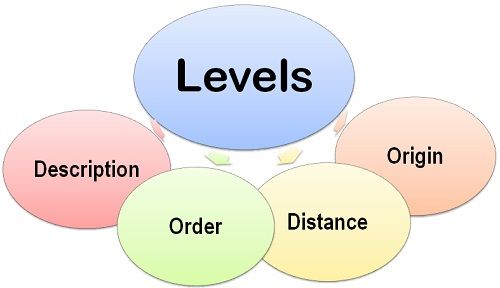Definition: The Levels of Measurement define the relationship among the values assigned to the characteristics of the object. In other words, what properties of an object the scale is measuring or not measuring is denoted by the levels of measurement.
All the scales used in research can be explained in terms of four basic characteristics; Description, Order, Distance, and Origin. These characteristics collectively define the levels of measurement.
- Description: The description means the unique labels and descriptors, that are used to designate the values of the scale. For example, the descriptors such as 1. Male, 2. Female. Thus, male and female are unique descriptors denoting values 1 and 2 of gender scale. All scales have unique descriptors or labels that are used to define the values of the scale and the response options.
- Order: The order refers to the relative size and position of the descriptor. Here, the order is associated with only relative values and no absolute values. Thus, the order is denoted by descriptors such as “Less than “, “greater than”, “equal to”. For example, respondent’s preference fro three brands of clothing is shown in the order given below with the most preferred brand listed first and the least preferred on the last.
- Louis Philippe
- Van Heusen
- Peter England
This shows that the preference for Louis Philippe is greater than the preference for Van Heusen, and likewise, the preference for Peter England is less than the preference for Van Heusen. It is important to note that all the scale does not possess order characteristic. Such as gender scale (1. Female, 2. Male) does not possess order as one cannot determine whether a female is greater than or less than male.
- Distance: By distance, we mean that the absolute differences between the descriptors on a scale are known and can be expressed in units. For example, a five-person classroom has one person more than a four-person classroom and likewise a four-person classroom has one person more than the three-person classroom.
It is to be noted that, the scale that has the distance characteristic also has the order. As we know that five-person classroom is greater than the four-person classroom in terms of a number of persons in class. Thus, we can say that distance implies order, but the reverse is not true, i.e. order does not necessarily imply distance.
- Origin: The origin shows that scale has a unique or fixed starting or true zero point. A scale that has origin characteristic also has the distance, order, and description. Many scales used in the marketing research do not have any fixed origin.
Such as, in case of unfavorable-favorable scale, where 1 = extremely unfavorable, 2 = unfavorable, 3 = neither unfavorable nor favorable, 4 = favorable and 5 = extremely favorable. Here, 1 is the arbitrary origin or starting point. This scale could have been started with 0, where 0 = extremely unfavorable and 4 = extremely favorable. Likewise, it can also be started with -2, where -2 = extremely unfavorable and 2 = extremely favorable. Thus, this scale does not have any fixed origin and hence does not possess the origin characteristic.
You must have observed that description, order, distance, and origin shows successively higher –level characteristics, with the origin being the highest level characteristic while the description the most basic characteristic. Such as, if the scale has order characteristic, then it will also have the description, and likewise the scale with distance characteristic has both the description and order. And the scale with origin characteristic has distance, order and description.
This shows that the higher level characteristics possess, the lower level characteristics, but however the lower level characteristics may not necessarily possess the higher-level characteristics.


Leave a Reply